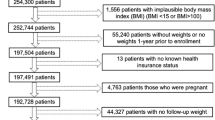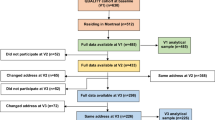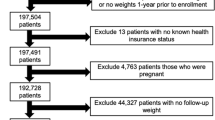Abstract
Objective:
To undertake a 6-year longitudinal investigation of the relationship between the built environment (perceived and objectively measured) and change in body mass index (BMI). Specifically, this research examined whether change in BMI was predicted by objectively measured neighborhood walkability and socioeconomic status (SES), and perceived neighborhood characteristics (for example, crime, traffic and interesting things to look at) in addition to other factors such as age, gender, education, physical activity, fruit and vegetable consumption and smoking.
Design:
Longitudinal study
Subjects:
500 adults who provided complete data in 2002 and 2008 and who did not move over the course of the study (47.8% female; age in 2002: 18–90 years).
Measurements:
Telephone surveys in 2002 and 2008 measuring perceptions of their neighborhood environment and demographic factors. Objective measures of neighborhood characteristics were calculated using census data and geographical information systems in 2006.
Results:
Age, neighborhood SES and perceived traffic were significantly related to increased BMI over the 6 years. Younger participants and those in lower SES neighborhoods were more likely to have increased BMI. Agreement with the statement that traffic made it difficult to walk also predicted increased BMI.
Conclusion:
This study adds to the literature to show that BMI increased in low SES neighborhoods. Although more research is needed to fully understand how neighborhood SES contributes to obesity, it is without question that individuals in socially disadvantaged neighborhoods face more barriers to health than their wealthier counterparts. This study also calls into question the relationship between walkability and changes in BMI and emphasizes the necessity of longitudinal data rather than relying on cross-sectional research.
This is a preview of subscription content, access via your institution
Access options
Subscribe to this journal
Receive 12 print issues and online access
$259.00 per year
only $21.58 per issue
Buy this article
- Purchase on Springer Link
- Instant access to full article PDF
Prices may be subject to local taxes which are calculated during checkout
Similar content being viewed by others
References
Kopelman P . Health risks associated with overweight and obesity. Obes Rev 2007; 8 (Suppl 1): 13–17.
Bowman TS, Kurth T, Sesso HD, Manson JE, Gaziano JM . Eight-year change in body mass index and subsequent risk of cardiovascular disease in healthy non-smoking men. Prev Med 2007; 45: 436–441.
Yarnell JWG, Patterson CC, Thomas HF, Sweetnam PM . Comparison of weight in middle age, weight at 18 years, and weight change between, in predicting subsequent 14 year mortality and coronary events: Caerphilly Prospective Study. J Epidemiol Community Health 2000; 54: 344–348.
Strandberg TE, Strandberg AY, Salomaa VV, Pitkala KH, Tilvis RS, Sirola J et al. Explaining the obesity paradox: cardiovascular risk, weight change, and mortality during long-term follow-up in men. Eur Heart J 2009; 30: 1720–1727.
Cerin E, Saelens BF, Sallis JF, Frank L . Neighborhood environment walkability scale: validity and development of a short form. Med Sci Sports Exerc 2005; 38: 1682–1691.
Frank LD, Sallis JF, Saelens B, Leary L, Cain K, Conway T et al. The development of a walkability index: application to the neighbourhood quality of life study. Br J Sports Med 2009. doi:10.1136/bjsm.2009.058701.
Leslie E, Coffee N, Frank L, Owen L, Bauman A, Hugo G . Walkability of local communities: using geographic information systems to objectively assess relevant environmental attributes. Health Place 2007; 13: 111–122.
Smith KR, Brown BB, Yamada I, Kowaleski-Jones L, Zick CD, Fan JX . Walkability and body mass index density, design and new diversity measures. Am J Prev Med 2008; 35: 237–244.
Vandegrift D, Yoked T . Obesity rates, income, and suburban sprawl: an analysis of U.S. states. Health Place 2004; 10: 221–229.
Lopez R . Urban sprawl and risk for being overweight or obese. Am J Public Health 2004; 94: 1574–1579.
Frank LD, Andresen MA, Schmid TL . Obesity relationships with community design, physical activity, and time spent in cars. Am J Prev Med 2004; 27: 87–96.
Gauvin L, Craig RC, Spivock M, Riva M, Foster M, Laforest S et al. From walkability to active living potential: an ‘ecometric’ validation study. Am J Prev Med 2005; 28: 126–133.
Spence JC, Cutumisu N, Edwards J, Evans J . Influence of neighborhood design and access to facilities on overweight among preschool children. Int J Pediatr Obes 2008; 3: 109–116.
Frank LD, Sallis JF, Conway TL, Chapman JE, Saelens BE, Bachman W . Many pathways from land use to health: associations between neighborhood walkability and active transportation, body mass index, and air quality. J Am Plann Assoc 2006; 72: 75–87.
Berke EM, Koepsell TD, Moudon AV, Hoskins RE, Larson EB . Association of the built environment with physical activity and obesity in older persons. Am J Public Health 2007; 97: 486–492.
Grafova IB, Freedman VA, Kumar R, Rogowski J . Neighborhoods and obesity in later life. Am J Public Health 2008; 98: 2065–2071.
Lee IM, Ewing R, Sesso HD . The built environment and physical activity levels: the Harvard alumni health study. Am J Prev Med 2009; 37: 293–298.
Casey AA, Elliott M, Glanz K, Haire-Joshu D, Lovegreen SL, Saelens BE et al. Impact of the food environment and physical activity environment on behaviors and weight status in rural U.S. communities. Prev Med 2008; 47: 600–604.
Burdette AM, Hill TD . An examination of processes linking perceived neighborhood disorder and obesity. Soc Sci Med 2008; 67: 38–46.
Boehmer TK, Hoehner CM, Deshpande AD, Brennan Ramirez LK, Brownson RC . Perceived and observed neighborhood indicators of obesity among urban adults. Int J Obes 2007; 31: 968–977.
Boehmer TK, Hoehner CM, Wyrwich K, Ramirez L, Brownson R . Correspondence between perceived and observed measures of neighborhood environmental supports for physical activity. J Phys Act Health 2006; 3: 22–36.
Sundquist J, Johansson S . The influence of socioeconomic status, ethnicity and lifestyle on body mass index in a longitudinal study. Int J Epi 1998; 27: 57–63.
Kavanagh AM, Goller JL, King T, Jolley D, Crawford D, Turrell G . Urban area disadvantage and physical activity: a multilevel study in Melbourne, Australia. J Epidemiol Community Health 2005; 59: 934–940.
Giles-Corti B, Donovan RJ . The relative influence of individual, social and physical environment determinants of physical activity. Soc Sci Med 2002; 54: 1793–1812.
Wilson DK, Kirtland KA, Ainsworth BE, Addy CL . Socioeconomic status and perceptions of access and safety for physical activity. Ann Behav Med 2004; 28: 20–28.
Lopez RP, Hynes HP . Obesity, physical activity and the urban environment: public health research needs. Environ Health 2006; 5: 25.
Harrington DW, Elliott SJ . Weighing the importance of neighbourhood: a multilevel exploration of the determinants of overweight and obesity. Soc Sci Med 2009; 68: 593–600.
van Lenthe FJ, Droomers M, Schrijvers CTM, Mackenbach JP . Socio-demographic variables and 6 year change in body mass index: longitudinal results from the GLOBE study. Int J Obes 2000; 24: 1077–1084.
International Physical Activity Questionnaire. Available : http://www.ipaq.ki.se/downloads.htm.
Statistics Canada. Canadian Tobacco Use Monitoring Survey. Available: http://www.statcan.gc.ca/survey-enquete/household-menages/tobacco-tabac/ctums-esutc-eng.htm.
Statistics Canada. Canadian Community Health Survey (CCHS) Cycle 2.2 (2004) Nutrition: General Health File and 24-Hour Dietary Recall. Available: http://www.statcan.ca/english/sdds/instrument/5049_Q1_V1_E.pdf.
Looker HC, Knowler WC, Hanson RL . Changes in BMI and weight before and after the development of type 2 diabetes. Diabetes Care 2001; 24: 1917–1922.
IPAQ research committee. Guidelines for Data Processing and Analysis of the International Physical Activity Questionnaire (IPAQ) 2005 Available: http://www.ipaq.ki.se/scoring.pdf.
Craig CL, Marshall AL, Sjöström M, Bauman AE, Booth ML, Ainsworth BE et al. International physical activity questionnaire: 12-country reliability and validity. Med Sci Sports Exerc 2003; 35: 1381–1395.
Alexander A, Bergman P, Hagstromer M, Sjostrom M . IPAQ environmental module; reliability testing. J Public Health 2006; 14: 76–80.
Statistics Canada. 2006 Census of Population. Profile for Canada, Provinces, Territories, Census Divisions, Census Subdivisions and Dissemination Areas, 2006 Census, 2008 May 2008. Catalogue no. 94-581-XCB2006002.
ESRI. ArcGIS (Version 9.2.) [Computer software]. ESRI: Redlands, CA, 2008.
Leslie E, Saelens B, Frank L, Owen N, Bauman A, Coffee N et al. Residents’ perceptions of walkability attributes in objectively different neighbourhoods: a pilot study. Health Place 2005; 11: 227–236.
Statistics Canada. 2001 Census of Population. Profile for Canada, Provinces, Territories, Census Divisions, Census Subdivisions and Dissemination Areas, 2001 Census, 2003. October 2003. Catalogue no. 95F-0495-X2001002.
Statistics Canada. Postal Code Conversion File (PCCF). March 2008. Catalogue no. 92-153-G.
Demissie K, Hanley JA, Menzies D, Joseph L, Ernst P . Agreement in measuring socio-economic status: area-based versus individual measures. Chronic Dis Can 2000; 21: 1–7.
Cervero R, Kockelman K . Travel demand and the 3Ds: density, diversity, and design. Transport Res 1997; 2D: 199–219.
Statistics Canada. Population 15 years and over by highest degree, certificate or diploma, by province and territory (2006 Census) (Alberta, British Columbia, Yukon Territory) (table) 2007. ‘2006 Census: Release topics’ [updated 2009 July 29; cited 2009 Nov 23]. Available from: http://www.40.statcan.gc.ca/l01/cst01/educ41c-eng.htm.
Statistics Canada. 2007 Table 051-0010 Population by marital status and sex, by province and territory (Alberta, British Columbia and Yukon) (table). CANSIM (database) [updated 2007 Nov 29; cited 2009 Nov 23]. Available from: http://www.40.statcan.gc.ca/l01/cst01/famil01c-eng.htm.
Statistics Canada. 2009 Table 281-0044 statistics Canada catalogue no. 72-002-X. Earnings, average weekly, by province and territory (table). CANSIM (database) [updated 2009 Aug 16; cited 2009 Nov 23]. Available from: http://www.40.statcan.gc.ca/l01/cst01/labr79-eng.htm.
Statistics Canada. 2009 Table 051-0001. Population by sex and age group, by province and territory (table). CANSIM (database) [updated 2009 Jan 15; cited 2009 Nov 23]. Available from: http://www.40.statcan.gc.ca/l01/cst01/demo31a-eng.htm.
Clark MI, Berry TR, Spence JC, Nykiforuk C, Carlson M, Blanchard C . Key stakeholder perspectives on the development of walkable neighbourhoods. Health Place 2010; 16: 43–50.
Sallis JF, Saelens BE, Frank LD, Conway TL, Slymen DJ, Cain KL et al. Neighborhood built environment and income: examining multiple health outcomes. Soc Sci Med 2009; 68: 1285–1293.
Lovasi GS, Neckerman KM, Quinn JW, Weiss CC, Rundle A . Effect of individual or neighborhood disadvantage on the association between neighborhood walkability and body mass index. Am J Public Health 2009; 99: 279–284.
Xuemei S, LaMonte MJ, Laditka JN, Hardin JW, Chase N, Hooker SP et al. Cardiorespiratory fitness and adiposity as mortality predictors in older adults. J Am Med Assoc 2007; 298: 2507–2516.
Lee DS, Chiu M, Manuel DG, Tu K, Wang X, Austin PC et al. Trends in risk factors for cardiovascular disease in Canada: temporal, socio-demographic and geographic factors. Can Med Assoc J 2009; 181: E55–E66.
Gorber SC, Tremblay M, Moher D, Gorber B . A comparison of direct vs self-report measures for assessing height, weight and body mass index: a systematic review. Obes Rev 2007; 8: 307–326.
Raine K, Spence JC, Church J, Boule N, Slater L, Marko J et al. State of the Evidence Review on Urban Health and Healthy Weights. Canadian Population Health Initiative, Canadian Institute for Health Information: Ottawa, ON, 2008.
Acknowledgements
This research was supported by grants from the Heart and Stroke Foundation of Canada and the Canadian Institutes of Health Research. Tanya R Berry is supported by a Population Health Investigator Award from the Alberta Heritage Foundation for Medical Research. Chris M Blanchard is supported by the Canada Research Chairs Program. The 2002 Population Health Survey was funded through Population Health and Research in the former Capital Health region of Alberta. We thank Genevieve Selfridge for her help with the manuscript.
Author information
Authors and Affiliations
Corresponding author
Ethics declarations
Competing interests
The authors declare no conflict of interest.
Rights and permissions
About this article
Cite this article
Berry, T., Spence, J., Blanchard, C. et al. Changes in BMI over 6 years: the role of demographic and neighborhood characteristics. Int J Obes 34, 1275–1283 (2010). https://doi.org/10.1038/ijo.2010.36
Received:
Revised:
Accepted:
Published:
Issue Date:
DOI: https://doi.org/10.1038/ijo.2010.36
Keywords
This article is cited by
-
A comprehensive walkability evaluation system for promoting environmental benefits
Scientific Reports (2023)
-
A longitudinal examination of objective neighborhood walkability, body mass index, and waist circumference: the REasons for Geographic And Racial Differences in Stroke study
International Journal of Behavioral Nutrition and Physical Activity (2022)
-
“Contextualizing Context”: Reconciling Environmental Exposures, Social Networks, and Location Preferences in Health Research
Current Environmental Health Reports (2017)
-
Utility of linking primary care electronic medical records with Canadian census data to study the determinants of chronic disease: an example based on socioeconomic status and obesity
BMC Medical Informatics and Decision Making (2016)
-
Movers and stayers: how residential selection contributes to the association between female body mass index and neighborhood characteristics
International Journal of Obesity (2016)



